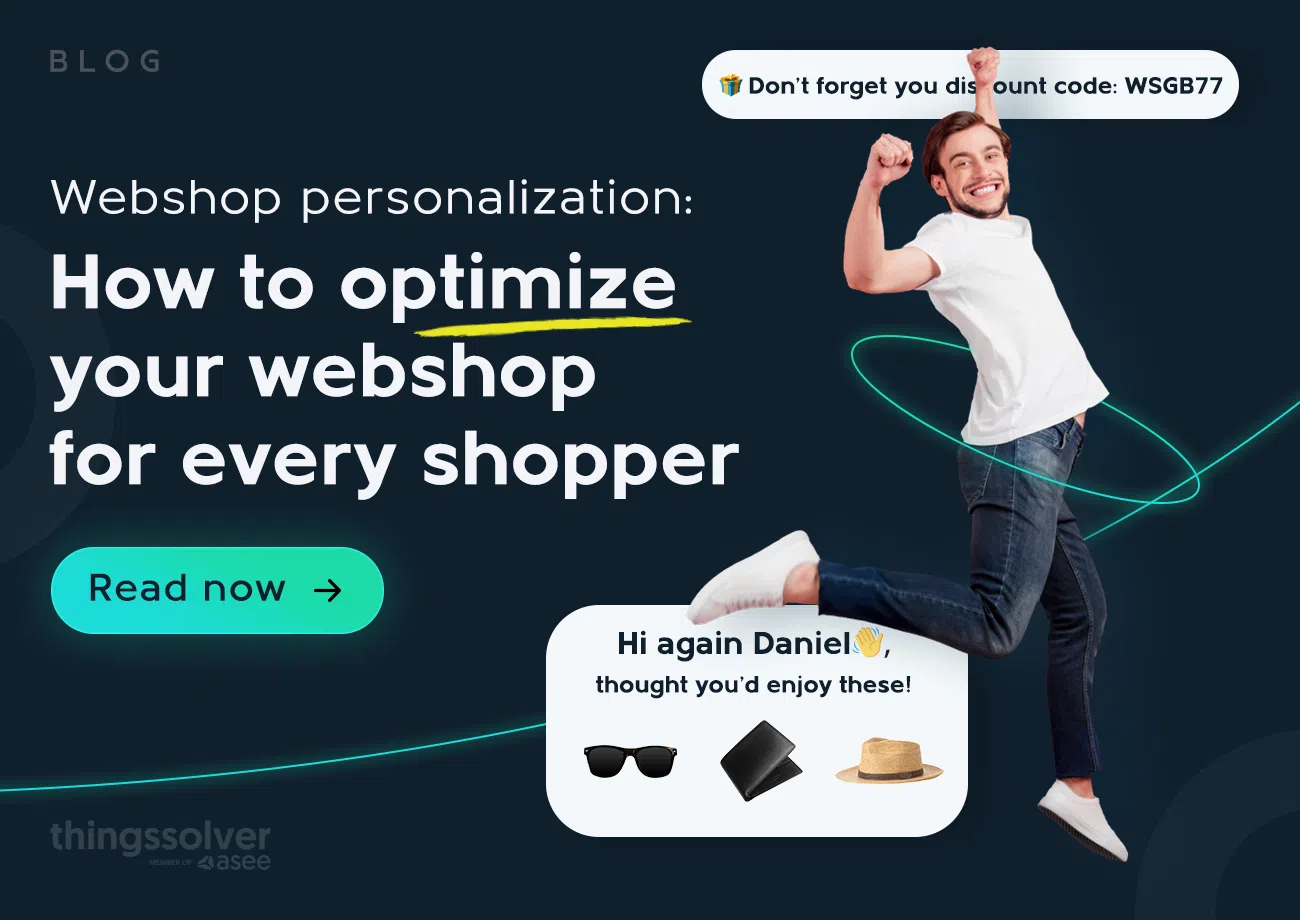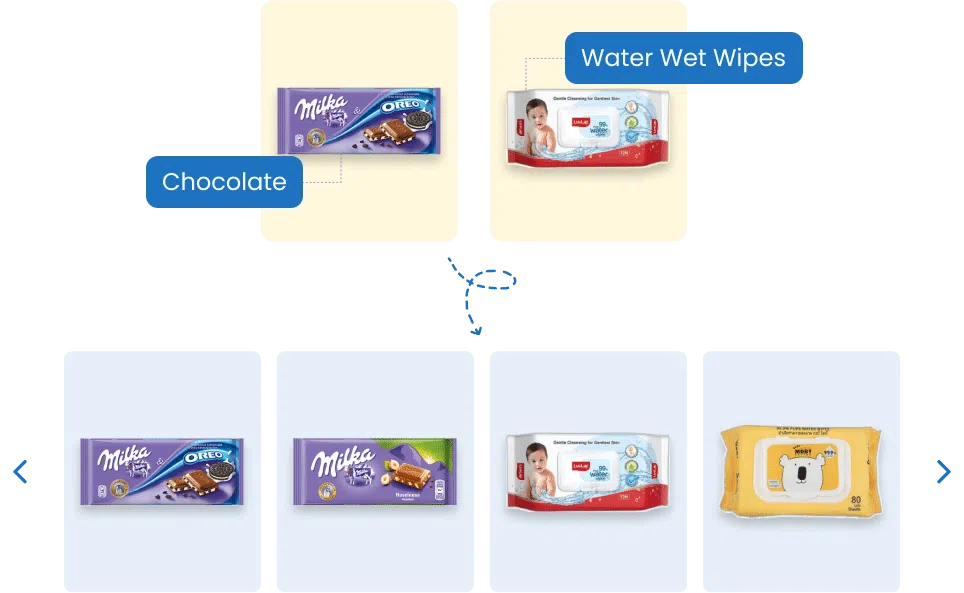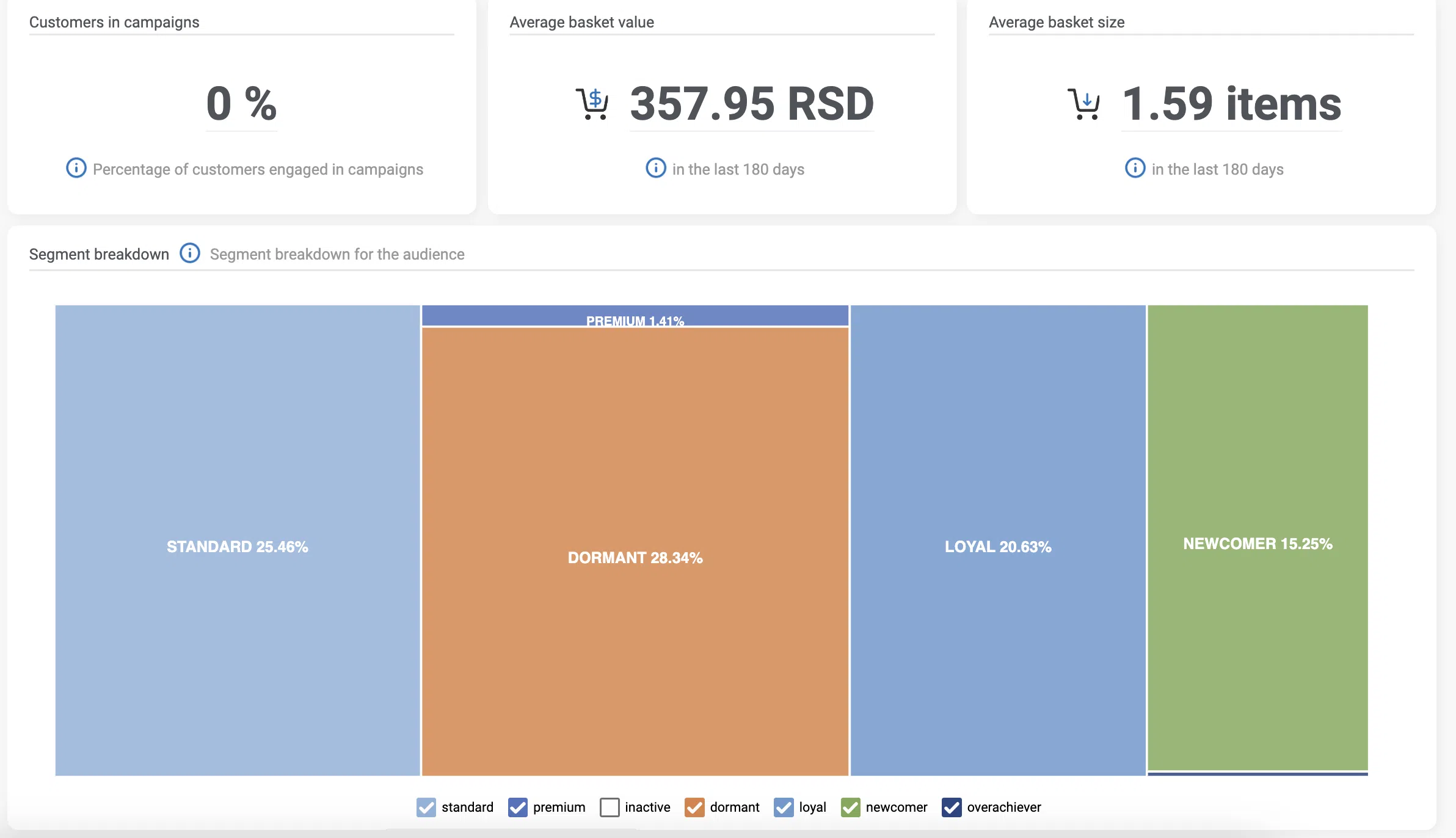What is conversational banking?
The financial industry is undergoing a digital revolution, with traditional methods of banking being replaced by faster, more efficient, and…
Read more03. 06. 2024.

You’re at that point where you know a lot about your target audience. For the past few months, you’ve worked hard to adjust your website according to what you’ve learned about them, having all their preferences and interests in mind.
Yet, you’re aware of one important fact — each website visitor comes with their own unique needs and preferences. So here comes the harder part: catering to the diverse needs of your customers.
If you have an online clothing store, a shopper looking for men’s formal wear won’t find much value in a homepage filled with women’s casual attire. How do you ensure both have a satisfying experience?
We have two words for you: Webshop personalization.
Stay with us to find out why you need webshop personalization and how to optimize your webshop for your customers.
Table of Contents
No matter if you’re new on the market or have been hanging on for a while, you know your shoppers need much more than just a generic shopping experience.
They crave personalization — tailored recommendations, bespoke offers, and content that speaks directly to their unique preferences and needs.
As e-commerce keeps evolving, the ability to deliver a personalized shopping journey has become a critical factor for better customer satisfaction and business success.
If this isn’t reason enough, here are 5 more reasons in favor of webshop personalization.
When a potential customer looking for women’s athletic wear lands on a website that’s dominated by men’s clothing and accessories, they might feel that this brand isn’t for them.
But they could be wrong only because the products they are looking for aren’t prominently featured on your website. And it would be such a shame to turn them away only because you haven’t optimized your webshop yet, right?
To capture their attention, make them feel welcome, and keep them engaged, you should make sure to tailor the landing page to their interests.
By delivering a personalized experience whenever possible, you can ensure more visitors find information relevant to them. This increases the likelihood that they’ll appreciate their interaction with your brand and choose to do business with you.
Website personalization might not be exactly like walking into a store where the staff greets you by name, but it’s the closest your website and webshop can achieve.
And let us tell you — people love it when you make them feel special!
In fact, according to Zendesk’s CX Trends 2024 report, 70% of consumers are spending more with companies that offer personalized and seamless customer experiences. It’s all about recognizing them, remembering them, and offering relevant offers and recommendations.
If you show your customers that you’re aware of their past interactions with the brand (past purchases, saves, likes, etc.) and use that knowledge to improve their experiences, it will most definitely help you create a better relationship with your customers.
Anyone who’s genuinely interested in improving user and website experience simply must try webshop personalization.
Personalization is the secret (or not so secret) ingredient that allows your shoppers to quickly find what they’re looking for. For example, they won’t have to search through the entire site to find your women’s athletic wear — it will be right there on the first page they land on.
With such an approach, you can count on increased convenience, save their precious time, and ensure they have a lovely experience on your site.
When you choose to personalize the content and products on your website and webshop, your shoppers are more likely to stay there longer. Personalization is a great way to boost those engagement rates.
If you keep showing your visitors products that match their preferences and interests, they might just keep adding them to their cart or they may keep exploring other products on your webshop because the headlines relate directly to their current needs.
We agree that website visits are important, but engagement metrics are a much better reflection of your website’s performance.
Although personalization is meant to turn your webshop into a valuable hub for your visitors and shoppers, it still has a deeper purpose — turning your visitors into shoppers by motivating them to take specific actions aka conversions.
The most important conversion any business is aiming for is purchases, but sometimes other actions are also valuable. This can include signing up for your email list or adding items to a wish list. No matter what actions you want visitors to take, personalization is a smart strategy to achieve that.
Webshop personalization means tailoring the shopping experience to meet each visitor’s unique needs and preferences. This is usually achieved through several types of personalization:
Behavioral personalization allows you to customize the shopping experience based on your customer’s browsing behavior, past purchases, and interactions on your website. By analyzing each visitor’s unique patterns, you can show them more relevant products and content that align closely with their interests and buying habits.
This type of personalization uses demographic information such as age, gender, location, and other data to tailor the shopper’s shopping experience.
For example, if your audience comprises people of different ages, you might want to display one set of products or offers to a young adult who lives in an urban area and a different set to a senior coming from a rural setting.
This method adjusts the content and products shown based on the current context of your shopper:
When you consider this sort of data, you’re making sure that their shopping experience is relevant to their immediate circumstances. This can also boost their engagement and increase the likelihood of making a purchase.
Now that you’ve understood why it’s important to invest in webshop personalization, let’s see how you can do that.
Bear in mind that you can use any of the strategies outlined below, depending on your business goals and plans.
When you have data on which products a visitor has previously viewed, you can use it to offer tailored recommendations when they visit your webshop the next time. This process can be automated with eCommerce personalization software, because it allows you to offer products that your website analytics suggest will interest your visitors based on their past behavior and shopping habits.
One effective solution for this can be Things Solver’s history-based recommender. By analyzing historic purchases, the system can predict and suggest items that the customer is likely to need or buy soon.

With such a proactive approach, you’re showing that you’re thinking ahead for your customers. When you choose to offer them products they will likely need very soon, you’re truly providing a fully personalized shopping experience.
Tailoring website content like banners, messages, and offers based on customer segments allows you to create a more engaging and relevant shopping experience.
For example, a returning customer who often buys skincare products might see banners promoting the latest skincare items, while a new visitor interested in electronics could see messages about the newest gadgets and special offers.
For this, you can rely on Things Solver’s Segmentation Studio to divide your customers into segments based on things like demographics, browsing behavior, and past purchases. Then, use additional personalization tools to create targeted content for each segment.
If you choose to have dynamic content on your webshop, it should change in real-time to show the most relevant information to different groups of customers.
Examples of dynamic webshop content include:
Making it easier for your shoppers to find what they want on your website should be your top priority. One great way to do this is by showing them search results that match their interests and align with their past behavior.
There are different search strategies you can implement to ensure webshop personalization and provide personalized search results to your shoppers and visitors.
These include:
Personalized search results are a great way to make the search experience more relevant and satisfying for your shoppers and improve webshop personalization.
To additionally boost your webshop personalization and encourage your visitors to do the right things, you can also start using more personalized calls to action (CTAs). The time of generic CTAs is long gone because personalized ones have the power to make all your messages more relevant and compelling.
How can you start personalizing the CTAs on your webshop?
Always start by analyzing customer data! This helps you understand your shopper’s preferences, browsing behavior, and past interactions. Then, use this information to create CTAs that speak directly to their needs.
For example, if one of your visitors often browses a particular category, you can show a CTA that would encourage them to further explore it. “Explore More in [Category]” or “Check Out Our Latest [Category] Deals” could be good options in these situations.
What’s more, don’t limit the use of personalized CTAs to your webshop only. Using them throughout your website can help boost engagement and conversion rates in the long run.
Creating personalized loyalty programs for returning customers can help you keep your most loyal customers engaged and satisfied.
To create personalized loyalty programs, you can analyze your customer data to understand their preferences, purchasing behavior, and how they interact with your brand.

For this part, customer segmentation can help you create programs that offer rewards and incentives relevant and appealing to your most loyal customer segment. Some successful personalized loyalty programs could include:
If you’re eager to drive repeat purchases, personalizing your loyalty programs can be a good way to make your customers feel valued and appreciated.
Everyone loves discounts and promotions, right?
And if they truly align with your shopper’s interests and current needs, you’re on the road to success. Since you already have so much data on your visitors and customers, why not use them to offer personalized discounts and promotions?
This way, you can make sure your discounts and promotions are always relevant. What’s more, your webshop personalization will be much more effective.
Once again, segmenting your shoppers based on their demographics or browsing behavior can help you create targeted promotions that align with each customer segment.
Some useful and effective strategies you could implement for this part could be:
Whatever you do, you always must have your shoppers in mind. If they’re having a great shipping experience on your website, they’ll be more than happy to come back.
This shows them that you understand their needs and preferences, which means they’ll reward you with continuous loyalty and long-term engagement.
Turning a visitor into a shopper is one of your biggest wins. But, making them keep coming back and buy from you again is an even bigger one.
Did you know that, according to the Baymard Institute, the average cart abandonment rate is about 70%? This means that only 3 out of 10 shoppers make it to checkout to complete their purchase.
So, what can you do for those repeat shoppers?
You have to make sure their check-out process is as smooth as possible. Providing them with an autofill option could be a smart move to improve your webshop personalization.
Why?
Well, if they have already created an account when they bought something on your website, you should simplify their next purchasing process. No one likes the hassle of putting their contact details every time they make a repeat purchase on the same website.
Allow them to autofill all the checkout information and make things easier for them. Making the check-out process as seamless as possible can increase your shoppers’ likelihood of completing a purchase. And that’s exactly what you want!
By using interactive and personalized customer service solutions, you can make your customers happier, keep them coming back, and stand out in a crowded market.
Thanks to the increasingly popular AI-driven tools, like chatbots, you can simplify the customer service process and get useful insights into what your customers want and need. This is particularly useful when you’re trying to improve your webshop personalization even more.
Chatbots are becoming more common on websites, and for good reason. When someone visits your site with a specific question or need, a chatbot can quickly give them the information they’re looking for. Chatbots create an interactive and personalized experience by guiding visitors based on their preferences and questions.
How can you set up chatbots effectively?
As you can see, implementing a chatbot feature into your webshop can be a good way to differentiate your brand with superior customer service.
Providing an exceptional, personalized shopping experience is no longer optional; it’s essential.
Webshop personalization allows you to tailor the shopping journey to meet the unique needs of your visitors and shoppers, making them feel seen and valued. Of course, this isn’t enough, so you must be at the top of your game, offering relevant product recommendations and making their check-out process as easy as possible. We hope that you can now better understand the importance of webshop personalization and feel more comfortable using different strategies to implement it effectively.
In case you’re still unsure about what to do or simply want to take your webshop to the next, feel free to reach out to us at ai@thingsolver.com!
We can help you get things started with webshop personalization so you can start delivering a customized shopping experience that keeps your shoppers coming back.
Get in touch with us today via email or book a free demo to start optimizing your webshop for every shopper.
The financial industry is undergoing a digital revolution, with traditional methods of banking being replaced by faster, more efficient, and…
Read moreYou’re running a business, constantly looking for ways to cut costs, boost efficiency, and increase revenue. But here’s the harsh…
Read moreAgentic AI will transform industries, but with one important exception — without consolidated data, even the most sophisticated AI systems…
Read more